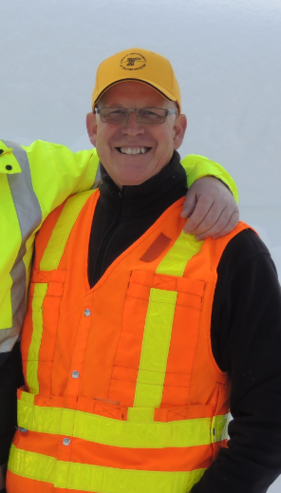 Telling their stories
Not all of the Oregon TIM family members are on the side of the road assisting motorists. Some of the Oregon TIM family have a more subtle but equally impactful lean to their job. Gary Leaming is one of those behind the scenes kind of people. He’s one of those people who you don’t necessarily see stopped on the side of the road or working in a construction zone, but he’s there everyday making sure all of us know about those who are. He’s always there to give relevance to a situation, tell a compelling story or strategically place an idea, all to bring awareness to the dangerous jobs you all do.
We are proud to introduce you to Gary this month for our responder spotlight.
TIM: How long have you worked as an ODOT communication specialist.
GARY: I’ve worked for ODOT for more than 17 years in project communication as well as assisting District with incident response, and now part of the Rogue Valley TIM Team. Before that I was a journalist in Eugene and Southern Oregon.
TIM: What do you love about your job?
GARY: I love the variety! I work with citizens and the media as part of our projects in development/construction - and with maintenance and operations, as well as our local emergency service providers. It’s a full pallet of daily challenges, along with the different personalities. No single day is exactly the same.
TIM: What are some of the ways you partner with other responders to keep the traveling public safe?
GARY: In my position, I communicate project information on our construction projects. Aside from the communication with the public and media, there is also an element in collaborating and communicating key project features to First Responders as to lane closures, detours, best routes to extract vehicles or crash victims. Much of this comes out of either one-on-ones or separate meetings with FR on some of our larger, more complicated projects. For example we had about 20 Medford-area FR’s attend a briefing when we began the Oregon 62 Expressway project. We briefed them and asked for their input on the best way to respond to crashes since a heavily congested area was going to lose key access points due to construction-related concrete barrier. It was successful and the FR appreciated the table top exercise.
TIM: In your experience, what is some vital information that can improve safe, quick clearance?
GARY: Timely, accurate and useful information is important in communicating to the public and media through Flash Alert, Twitter (@OregonDOT) and Tripcheck. Given them the information, including photos, from the scene allows the public and the media to quickly understand what’s going on. The old adage ‘a picture is worth a thousand words’ is true. Good pictures will get picked up by traditional and social media and shared. It translates into modified behavior and fewer complaint calls since the public can either delay or modify their travel schedule. In turn, it frees up the system so our First Responders can work the scene and reduce the chances of a secondary crash.
TIM: What are some of the ways we can strengthen the communication, coordination and collaboration between response partners?
GARY: Individuals and agencies need to see the value of working as a team - for the safety of each other and the public. If there are egos involved, they need to be put aside and remember why they do what they do. It’s a commitment to teamwork and public safety. It may be as simple as explaining one-on-one the value and learning/networking opportunities of TIM. We can all certainly learn from each other.
TIM: Tell us about a Traffic Incident Management success that you have been a part of.
GARY: A few examples I would cite include:
- The Rogue Valley TIM video that explains the mission and teamwork needed for a successful program.
- First Responder meetings that have shown various traffic challenges due to construction and the resulting teamwork and strategies for working crashes in a congested work zone.
- Some of the relationship building we’ve had with Jackson Co. Fire District 3 and how we’ve incorporated some of their suggestions into the project plans to make for a more accessible Rogue Valley Expressway, which will open early next year.
- Fire District #5 (south Jackson County) annual community open house.
- I-5 Siskiyou Pass Paving project coming next year. We’re are pulling together an easy to understand staging map to help the incident management challenges we know will come from several required crossovers and ramp closures on this project between the California border and Ashland.
TIM: How is your agency investing in Traffic Incident Management?
GARY: We are fully invested in TIM at a statewide level and in the Rogue Valley through quarterly meetings and training opportunities. We’re seeing those pay off with better teamwork, communication and trust between the FR’s. They know when our IR’s arrive at a scene or incident, we have their back.
TIM: What is your favorite thing to do outside of work?
GARY: Love to hike, fish and camp – anything with the outdoors.
TIM: What is your favorite and why?:
We gave Gary three topics to tell us about his favorite one. He gave us answers to all three. Here they are:
- Sports team: Oregon Ducks – my alma mater.
- Dessert: Cherry Pie (I cannot lie)
- Time of year: Love the spring, summer and fall – with the exception of the smoky summer season.
|